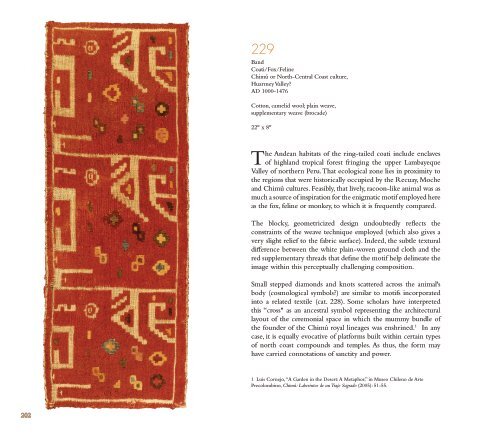You also want an ePaper? Increase the reach of your titles
YUMPU automatically turns print PDFs into web optimized ePapers that Google loves.
229<br />
Band<br />
Coati/Fox/Feline<br />
Chimú or North-Central Coast culture,<br />
Huarmey Valley?<br />
AD 1000-1476<br />
Cotton, camelid wool; plain weave,<br />
supplementary weave (brocade)<br />
22" x 8"<br />
The Andean habitats of <strong>the</strong> ring-tailed coati include enclaves<br />
of highland tropical forest fringing <strong>the</strong> upper Lambayeque<br />
Valley of nor<strong>the</strong>rn Peru. That ecological zone lies in proximity to<br />
<strong>the</strong> regions that were historically occupied by <strong>the</strong> Recuay, Moche<br />
and Chimú cultures. Feasibly, that lively, racoon-like animal was as<br />
much a source of inspiration for <strong>the</strong> enigmatic motif employed here<br />
as <strong>the</strong> fox, feline or monkey, to which it is frequently compared.<br />
The blocky, geometricized design undoubtedly reflects <strong>the</strong><br />
constraints of <strong>the</strong> weave technique employed (which also gives a<br />
very slight relief to <strong>the</strong> fabric surface). Indeed, <strong>the</strong> subtle textural<br />
difference between <strong>the</strong> white plain-woven ground cloth and <strong>the</strong><br />
red supplementary threads that define <strong>the</strong> motif help delineate <strong>the</strong><br />
image within this perceptually challenging composition.<br />
Small stepped diamonds and knots scattered across <strong>the</strong> animal's<br />
body (cosmological symbols?) are similar to motifs incorporated<br />
into a related textile (cat. 228). Some scholars have interpreted<br />
this “cross" as an ancestral symbol representing <strong>the</strong> architectural<br />
layout of <strong>the</strong> ceremonial space in which <strong>the</strong> mummy bundle of<br />
<strong>the</strong> founder of <strong>the</strong> Chimú royal lineages was enshrined. 1 In any<br />
case, it is equally evocative of platforms built within certain types<br />
of north coast compounds and temples. As thus, <strong>the</strong> form may<br />
have carried connotations of sanctity and power.<br />
1 Luis Cornejo, “A Garden in <strong>the</strong> Desert: A Metaphor,” in Museo Chileno de Arte<br />
Precolombino, Chimú: Laberintos de un Traje Sagrado (2005): 51-55.<br />
202







